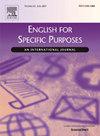跨语言实践的多模态方法:在EMI商业课程中从跨语言到跨符号化
IF 2.7
1区 文学
Q1 LINGUISTICS
引用次数: 0
摘要
高等教育中英语媒介教学的出现增加了人们对翻译语言的兴趣,这涉及到使用个人的语言技能作为教学工具来支撑内容理解。然而,意义的形成并不仅仅是语言的产物;相反,它产生于语言和其他符号资源之间的相互作用。在EMI讲座中,学生需要理解母语以外语言的学科内容。因此,讲师必须寻找不同的策略,使这些具体的内容更容易理解。为了理解EMI讲师如何传达学科内容,本文探讨了译语和其他符号学模式的作用,重新审视了译语的功能,以便我们可以将它们重新定义为跨符号学实践。收集的数据包括两段商业课程的视频。根据Sahan和Rose的分类(2021年),从混合的方法,我们的目标是定量和定性地分析讲师使用翻译语言的情节。然后,我们使用多模态语篇分析视角和GRAPE-MARS软件来研究这些情节的多模态性质。结果表明,由于讲师使用母语来检查学生的理解,解释或澄清所呈现的内容,翻译技术词汇,提供反馈和建立融洽关系,因此跨语言具有明显的教学功能。此外,根据上述功能,讲师采用特定的多模态合奏,这加强了跨语言实践。因此,这种做法应该被重新定义为跨符号化,因为它为EMI课堂内的交流提供了一种更全面的方法。本文章由计算机程序翻译,如有差异,请以英文原文为准。
Multimodal approach to translanguaging practices: From translanguaging to trans-semiotising in an EMI business course
The emergence of English Medium Instruction in Higher Education has increased the interest in translanguaging, which involves using individuals' linguistic repertoire as a pedagogical tool to scaffold content comprehension. Nevertheless, meaning-making is not solely a product of language; rather, it emerges from the interaction between language and other semiotic resources. In EMI lectures, students need to understand disciplinary content in a language other than their L1. Consequently, lecturers must look for different strategies to make such specific content more accessible and comprehensible. In order to understand how disciplinary content is conveyed by an EMI lecturer, this paper explores the role of translanguaging and other semiotic modes to revisit the functions of translanguaging so that we can redefine them as trans-semiotising practices. The data collected included two video-recorded lectures from a Business course. Following Sahan and Rose's taxonomy (2021) and from a mixed-based approach, we aim at analysing quantitatively and qualitatively the episodes where translanguaging was employed by the lecturer. We then examine the multimodal nature of those episodes using the Multimodal Discourse Analysis perspective and the GRAPE-MARS software. Results show that translanguaging has a clear pedagogical function since the lecturer employs the L1 to check students' comprehension, explain or clarify presented content, translate technical vocabulary, provide feedback, and build rapport. Moreover, depending on the aforementioned functions, the lecturer employs specific multimodal ensembles, which reinforce translanguaging practices. Hence, this practice should be redefined as trans-semiotising because it offers a more comprehensive approach to communication within the EMI classroom.
求助全文
通过发布文献求助,成功后即可免费获取论文全文。
去求助
来源期刊

English for Specific Purposes
LINGUISTICS-
CiteScore
5.70
自引率
8.00%
发文量
41
审稿时长
62 days
期刊介绍:
English For Specific Purposes is an international peer-reviewed journal that welcomes submissions from across the world. Authors are encouraged to submit articles and research/discussion notes on topics relevant to the teaching and learning of discourse for specific communities: academic, occupational, or otherwise specialized. Topics such as the following may be treated from the perspective of English for specific purposes: second language acquisition in specialized contexts, needs assessment, curriculum development and evaluation, materials preparation, discourse analysis, descriptions of specialized varieties of English.
 求助内容:
求助内容: 应助结果提醒方式:
应助结果提醒方式:


